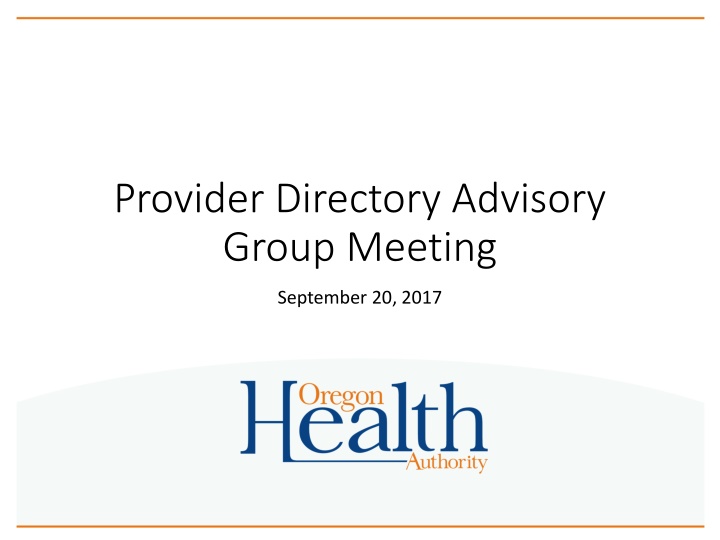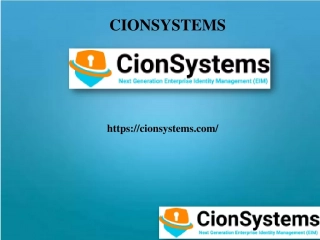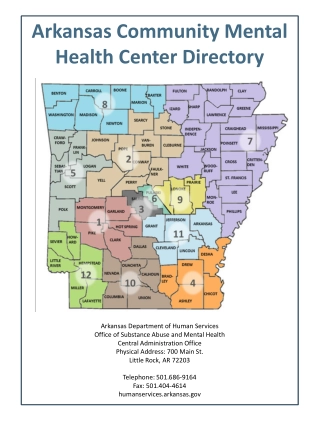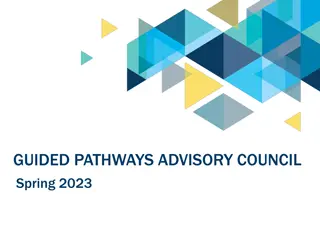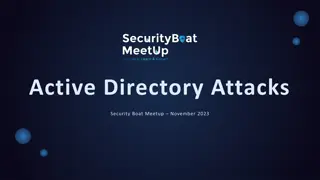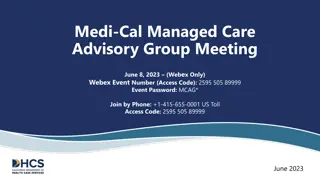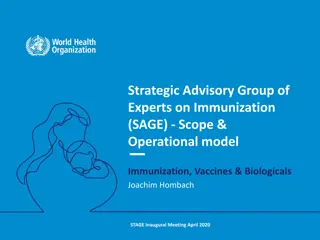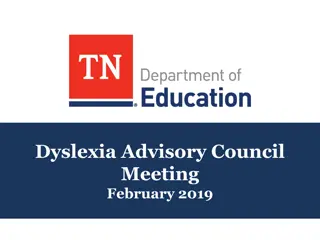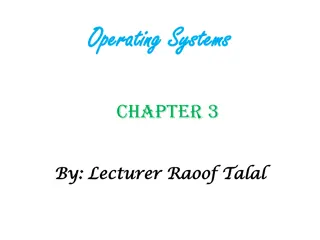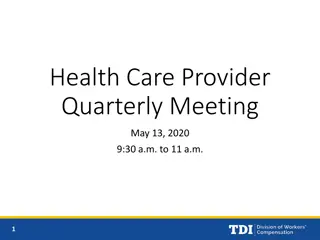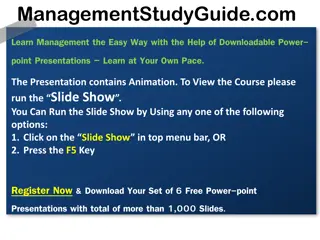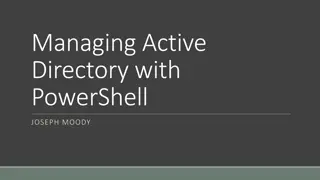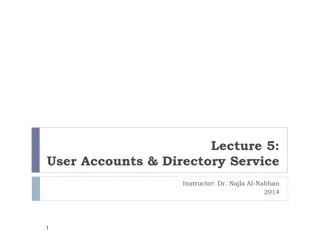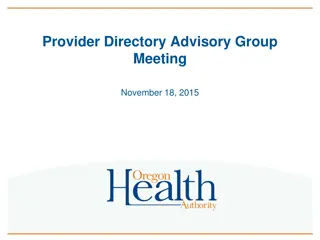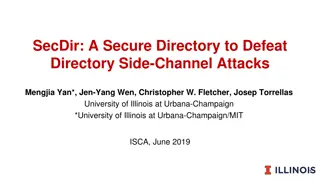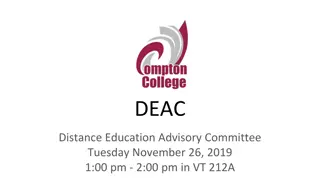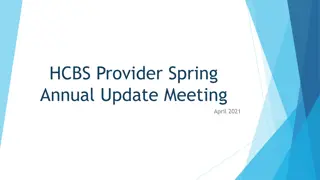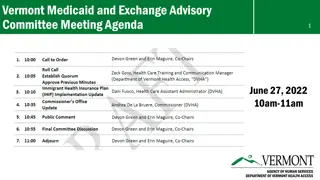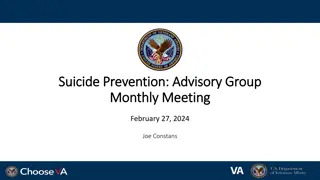Provider Directory Advisory Group Meeting - Updates and Discussions
The Provider Directory Advisory Group Meeting held on September 20, 2017, addressed various updates including HIT Commons, Credentialing, and procurement discussions. Key outcomes focused on creating an umbrella statement and an action plan for stakeholder engagement. Updates since the previous meeting were also shared, emphasizing the importance of accurate provider information and network affiliations. The meeting aimed at enhancing coordination and decision-making processes for HIT efforts.
Download Presentation

Please find below an Image/Link to download the presentation.
The content on the website is provided AS IS for your information and personal use only. It may not be sold, licensed, or shared on other websites without obtaining consent from the author.If you encounter any issues during the download, it is possible that the publisher has removed the file from their server.
You are allowed to download the files provided on this website for personal or commercial use, subject to the condition that they are used lawfully. All files are the property of their respective owners.
The content on the website is provided AS IS for your information and personal use only. It may not be sold, licensed, or shared on other websites without obtaining consent from the author.
E N D
Presentation Transcript
Provider Directory Advisory Group Meeting September 20, 2017
Welcome! Roll call and agenda review 5 min Provider Directory updates 10 min HIT Commons update 25 min Common Credentialing update 15 min Provider Directory procurement 5 min Provider Directory adoption planning discussion (10 min break around 2:30) Adoption roadmap discussion (Umbrella statement) Action plan discussion Key users Identification small group breakouts Close 10 min
Meeting outcomes By the end of today s meeting, we will have: 1. An updated umbrella statement for the Provider Directory that explains in a nutshell why we re doing this work 2. A drafted action plan that outlines how PDAC and PD-SME will be involved 3. An updated key organizations list of stakeholders to engage
Provider Directory Updates Karen Hale
Updates since last time PD SME meeting on August 9th Use case reviews to clarify purposes and prioritize Removed use cases: network adequacy and in-network search Other discussion highlights: Network affiliations and private carriers are difficult to track; there is value in knowing affiliations of providers to commercial carriers and Medicaid/CCOs Provider Directory may not support a referrals use cases fully but enable having the correct practice information for a provider Accepting new patients remains tricky Common Credentialing will have these fields but they are not mandatory fields In August, OHA talked to Medicare Advantage (MA) compliance and policy staff to get a better sense of MA policies and alignment with the Provider Directory PDAC and PD-SME nominations
HIT Commons: Update and Progress Sean Carey Lead Analyst, OHA
Why pursue an HIT Commons? Key Opportunities and Objectives Establish a stakeholder-led, neutral governance and decision-making process for investing in HIT efforts Leverage opportunities for shared funding of efforts with statewide impact Coordinate efforts to enable a network of networks for HIE Facilitate access to high-value data (e.g., Prescription Drug Monitoring Program) Support core infrastructure needed for care coordination and alternative payment models 7
Anticipated Benefits of an HIT Commons Achieve HIT goals more effectively with critical mass Coordinate and support shared interests of health care stakeholders and OHA to meet the vision of a transformed health delivery system optimized by HIT Support cooperation and data sharing to improve care for all Oregonians Accelerate adoption and spread of HIT initiatives Support a stakeholder-led process that allows those closest to the work ability to govern and direct efforts Shared equitable funding supports entities that face resource barriers to raise all boats Maximize Oregon s state and federal resources to advance HIT optimized health care 8
Building an HIT Commons Business Plan Goal: Build an HIT Commons model to accelerate Oregon s progress toward an HIT-optimized health care delivery system Build on the success of EDIE/PreManage Governance model OHA grant to OHLC, joint team to staff effort Sensing Sessions: Staff-led discussions with HITOC and other advisory committees and individual stakeholders to gather themes, over 50 organizations represented HIT Commons Interim Advisory Group: Limited duration, interim committee to lead evaluation & merit of Public/Private partnership for HIT 9
Proposed Management Structure Initially expand on EDIE governance model Leverage OHLC as fiscal agent and management staff Interim Advisory Group continues to meet to nominate the new HIT Commons Board to serve staggered three-year terms Representative board positions mirror EDIE Utility with some additions. Geographical diversity, positional (e.g., technical, operational, etc.) diversity, consumer representation. Eventually establish new 501(c)(3) after successful launch 10
Proposed HIT Commons Initiatives and Funding Initial scope and process for adding new projects RACI needed on each initiative to clarify role(s) of the Commons and ensure alignment with OHA and other partners Criteria/process for adding new projects, maintaining independence for adopting new projects Further definition about how ideas come to HIT Commons for consideration Funding model: Two components for Commons administration and initiative-specific costs: Available OHA/Medicaid HITECH funds for Medicaid share of development and implementation; and, Dues built on the current EDIE dues structure spreading costs across participants Initial OHLC funding for start up (OHLC Board 8/1/17) 11
Potential Health IT Governance Galaxy Policy Board PDAC EDIE Utility Public Advisory and Oversight Bodies HITOC HIT Network of Networks HIT Portfolio Exec Steering Other Efforts HCOP CCAG Commons HITAG OHIT (OHA) PDMP Gateway Funding OHLC PDAC: Provider Directory Advisory Committee CCAG: Common Credentialing Advisory Group HCOP: HIT/HIE Community and Organizational Panel HITAG: CCO HIT Advisory Group 13
HIT Commons Success Measures and Next Steps Each initiative will establish success metrics HIT Commons potential governance measures (to be defined by the new board): HIT Commons projects are statewide in nature or have broad impact on health care delivery Oregon health care stakeholders are aware and feel represented by HIT Commons HIT Commons projects advance HITOC stated goals HIT Commons projects have clear value propositions (Financial ROI, measurable in quality, care delivery, experience of care) Next Steps: Fall 2017: Stakeholder presentations, endorsements 2018: Transition to new HIT Commons 14
Common Credentialing Update Melissa Isavoran, Common Credentialing Program Manager
CC Implementation Team Call Center Help Desk Support Responsible for all Medversant deliverables Single Sign On and enrollment solution for CC Implementation OHP currently supports 9,945 Organizations and 42,345 subscribers in Oregon (OCCS overlap unknown) Prime Contractor Program Management System Integration Analysis Testing Services CVO Services Common Credentialing Portal Software configuration efforts to enhance credentialing software to meet OHA s requirements
Progress Update OHA executed contract with Peraton on March 23, 2017, delayed subcontracts with Conduent and Medversant finalized on July 28, 2017 Contract delays will bump go-live from 2nd to 3rd quarter of 2018 Fee model adjustments and health system treatment: oContinuing work on health system treatment with DOJ and stakeholders oFinal fee model inclusive of any discounts to be placed in final rule Rule development: Public hearing conducted and written comments period ended in August Extended comment period through October 30, 2017 oFinal rule changes to stakeholders via a final RAC on October 25, 2017 oFinal rule to be filed no later than January 1, 2018 17
Progress Update, Continued Directing and managing system configuration with vendors Drafting credentialing and operational policies Working with key stakeholders on health system treatment Consulting with accrediting entities to ensure buy-in Establishing a process for optional interfaces Developing fiscal services process for COs and practitioners Creating marketing and outreach materials Solidifying quality and compliance processes Engaging a technical advisory group for ad hoc assistance with system development and user acceptance testing 18
Project Delay Lessons learned Subcontract negotiations took four months longer than expected due to required additional scrutiny of terms and conditions by subcontractor legal counsel Peraton ready to execute contract with MiHIN as soon as OHA receives CMS approval Revisited Peraton resourcing 19
Provider Directory Implementation update Rachel Ostroy, Implementation Director
Strategies and Plans created to date Communications strategy Adoption and Program Roadmap Action Plan Set of communications objectives, audiences, key messages, spokespeople, channels and tools, and strategies that describe the approach to communicate about the Provider Directory Last updated in January 2017 minor updates in July Set of adoption and program related objectives, measures, tactics, and metrics to describe how we intend to reach success Last updated July 2017 Activities and tasks that need to be completed to meet the objectives in the roadmap Governance and quality Market Analysis Sustainability Marketing & Outreach Adoption activities Last Updated July 2017 Adoption Plan
Review and update roadmap Need to update today Umbrella Statement Why we are all here Objectives How we know we are successful New draft based on feedback from last meeting Tactics how we will achieve objectives Metrics How we measure success
Roadmap umbrella statement discussion How should the roadmap mission be updated to reflect what and why we doing this work? 1. HIT Commons Business Plan 2. Roadmap mission 3. PDAC comments Serve as Oregon s directory of accurate, trusted provider data. It will support care coordination, health information exchange, administrative efficiencies, and serve as a resource for heath analytics. Authoritative data sources that feed the provider directory will be matched and aggregated and data stewards will oversee management of the data to ensure the Provider Directory maintains initial and long term quality information. Provide Oregon healthcare entities a one-stop-shop for trusted, complete, and accurate provider and practice information to improve: Operational administrative efficiencies Health information exchange Data used for healthcare analytics Three priority statements from July meeting s future state discussion: This saved me money (money, cost, downstream effects) Data was maintained, accurate, and trustworthy Data was value added to the business Other prior PDAC comments It s a no brainer if it helps patients Must have integrity; can t be a flavor of the month
Action plan review and discussion Data Marketing and outreach Market analysis governance and quality Adoption Sustainability What does PDAC/PD-SME engagement look like for each area? 1. Level of engagement? Level 1 Highest level of engagement and importance Consulted for input, reviewing/drafting documents, presenting/providing information to others, testing, etc. PDAC/PD-SME shares responsibility for completion Level 2 Mid range level of engagement and importance Consulted for input during PDAC or PD-SME meeting or with a subgroup OHA and vendor are responsible for completion Level 3 Lower level of engagement Informed via email or meeting update OHA and vendor are responsible for completion 2. Who needs to be involved? 3. What types of activities? How?
Key users discussion 1. Who are the key audiences within the group? 2. What is their interest? Influence? 3. Are they currently engaged? 4. What is the best way to connect? For each user grouping Health Plans CCOs Dental Care Organizations (DCOs) Health Information Exchanges (HIE) Independent Physician Association (IPA) Providers and Clinics (includes dental and behavioral) Health Systems/Hospitals Long term care Tribal Research organizations (not marketing) Skilled nursing facilities Software organizations and vendors First responders Fire departments Other User groups
Classification and levels of engagement High Influence High Interest Partnership High Influence Low Interest Participation Low Influence High Interest Consultation Low Influence Low Interest Push communications Pull communications
Close What worked well? How can we improve? Next PDAC meeting is November 15th Next PD-SME meeting is October 11th
